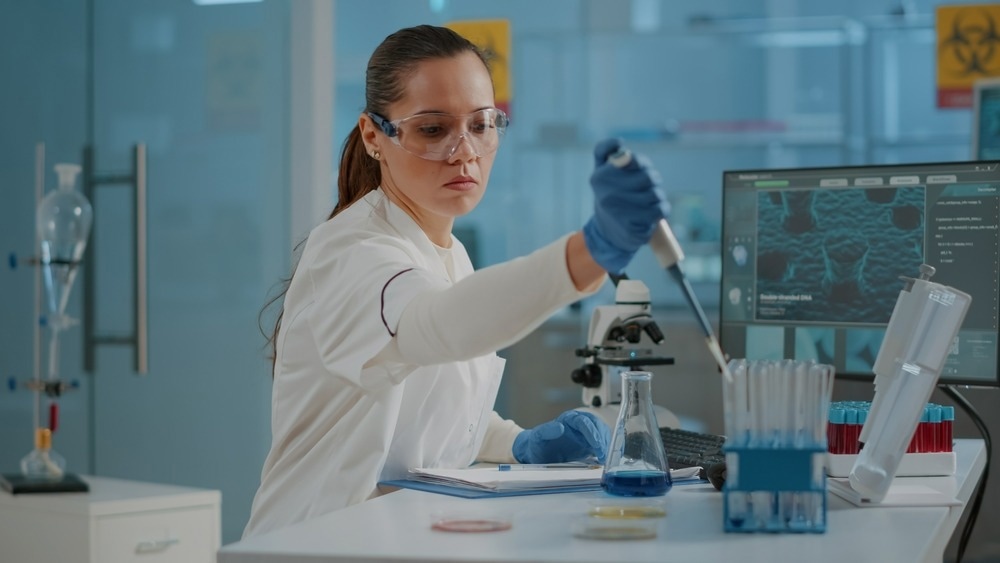In this interview, we delve into the journey and research of Sona Krajcovicova, exploring how diverse interests led to a passionate pursuit of chemistry, innovative approaches to drug development, and a commitment to making a meaningful impact on the world of therapeutics.
Please could you introduce yourself and briefly overview your career?
I was born and raised in Bratislava, Slovakia, where I completed my elementary school and gymnasium education. For my university studies, I moved to the Czech Republic in 2010, where I have lived since.
As a child, I aspired to become a medical or veterinary doctor. Later on, I aspired to be an architect or a psychologist. It wasn't until my penultimate year at the gymnasium that I truly delved into the enchanting world of chemistry, and it felt like a calling.
To reconcile my desire to help people and engage in meaningful work, I applied for Biochemistry at Masaryk University in Brno for my bachelor's degree. Although I initially pursued Biochemistry, I soon realized that my true passion lay in Organic Chemistry.
Fortunately, I was able to take many Chemistry courses, and for my Master's degree, I specialized solely in Organic Chemistry. It proved to be the best decision I could have made for my career.
After completing my Master's, I decided to continue my academic journey in Olomouc, another city in Czechia, for my Ph.D. I spent four amazing years as a Ph.D. student in the group led by Professor Soural. I am forever grateful for the opportunity to work in his group. Without his support and the challenging projects he entrusted me with, I wouldn't be where I am today.
But as I always had a desire to go abroad for a longer period of time, after my Ph.D. I was looking for a postdoc outside Czechia – and I then found Prof. Spring at the University of Cambridge. Being in his group as a postdoc has become another life-changing experience. I am very fortunate to have met these two mentors who supported me in every career decision and have always been on my side.
How has your background in biochemistry influenced your work in synthetic organic chemistry and the development of novel therapeutics?
My background in biochemistry has profoundly shaped my approach to synthetic organic chemistry and developing novel therapeutics. It has given me a solid foundation in understanding how biology functions at the molecular level. This understanding is invaluable when it comes to designing and building compounds or bioconjugates for the development of novel therapeutics.
It also gives me a unique perspective, allowing me to effectively bridge the gap between chemistry and biology. This interdisciplinary knowledge enables me to create molecules that are not only synthetically feasible but also biologically relevant. In essence, it allows me to speak both the language of chemistry and the language of biology.
My ultimate goal has always been to make a meaningful impact on humanity by contributing to developing useful molecules. While I may not be working in a hospital as a medical doctor, I can still fulfill my desire to help people by creating molecules that can potentially treat diseases and improve lives.

Image Credit: DC Studio/Shutterstock.com
Can you provide an overview of your talk at ELRIG Drug Discovery 2023? What inspired you to choose this particular topic?
During my presentation at ELRIG Drug Discovery 2023, I discussed two major topics from my postdoctoral work. The first topic centered around novel peptide stapling techniques, particularly the tryptophan-mediated Petasis reaction (TMPR) development. This reaction has a significant advantage in enabling late-stage functionalization of stapled peptides, a process that is often challenging with conventional methods. The TMPR method offers solutions to issues like cross-reactivity and reagent stability, which can be encountered when working with deprotected peptides. It's a versatile method that brings many advantages over the conventional ones and can be applied in solution or on solid-phase.
The second topic I covered was the synthesis of third-generation TetraDVP linkers for bioconjugation to native antibodies. TetraDVP linkers have several advantages over usually used maleimides, including greater stability, irreversible conjugation, and the ability to target all four disulfide bonds in IgG1 antibodies. This precise control over the drug-to-antibody ratio (DAR) is crucial for the development of antibody-drug conjugates (ADCs).
I chose these topics because they represent significant advancements in the field of drug discovery and development. They offer practical solutions to challenges in creating therapeutics with improved stability, specificity, and efficacy.
In your presentation, you discussed the utilization of tryptophan in multicomponent Petasis reactions for peptide stapling. Could you explain the significance of this approach in the context of next-generation therapeutics?
Conformationally constrained, or stapled, peptides are considered the next generation of therapeutics due to their enhanced stability against enzymes and proteases in the human body. These stable peptides have gained popularity as conjugates with different drugs, known as peptide-drug conjugates (PDCs), or as enhancements for cells, such as lipidic or fluorescent tags.
One of the key challenges in developing PDCs is the late-stage functionalization of these stapled peptides. Conventional methods often involve working with deprotected peptides, which can be cumbersome for organic chemists due to their multiple reactive residues, leading to cross-reactivity issues. Additionally, these methods may require biorthogonal reactions, which, while powerful, can be slow and have limitations.
The significance of the tryptophan-mediated Petasis reaction (TMPR) lies in its ability to overcome these challenges. TMPR offers a practical solution for late-stage functionalization of stapled peptides. It allows for orthogonally controlled reactions, simplifying the synthesis process and providing greater flexibility. This method has the potential to streamline the preparation of various PDCs, ultimately accelerating the development of next-generation therapeutics.
One of the key challenges in peptide stapling is maintaining binding interactions and stability while incorporating biologically relevant tags. How does the tryptophan-mediated Petasis reaction (TMPR) address these challenges?
Addressing the challenge of maintaining binding interactions and stability while incorporating biologically relevant tags in stapled peptides is crucial for their effectiveness as therapeutics. As the presentation has shown, in the first proof-of-concept stage we focused mainly on the synthetic aspects of the method showcasing its versatility. We are now at the next phase of our research where we are applying the concept to a plethora of different biologically active peptides - and from the preliminary results it is evident that they have not lost their binding affinities to their targets even after they are stapled by this method. This means that the stability of the peptide's binding interactions can be preserved using our TMPR method while incorporating biologically relevant tags.

Image Credit: murat photographer/Shutterstock.com
Your talk also covered the synthesis of third-generation TetraDVP linkers for bioconjugation to native antibodies. What advantages do these linkers offer over previous generations, and how do they contribute to the development of antibody-drug conjugates (ADCs)?
TetraDVP linkers, particularly the third-generation ones, offer several advantages over usually applied maleimides, making them valuable contributors to the development of antibody-drug conjugates (ADCs). These advantages include:
Greater Stability: TetraDVP linkers are known for their stability. Compared to other commonly used linkers, such as maleimides, TetraDVP linkers are more robust. This stability is crucial for ensuring that the conjugation between the linker and the antibody remains intact throughout the ADC's journey in the body.
Irreversible Conjugation: TetraDVP linkers form irreversible bonds with antibodies. This irreversible conjugation ensures that the whole bioconjugate including payload remains attached to the antibody, even in the presence of various physiological conditions. This stability is essential for maintaining the therapeutic efficacy of ADCs.
Precise Control of Drug-to-Antibody Ratio (DAR): Achieving homogeneity and precise control of the drug-to-antibody ratio (DAR) is crucial for ADCs. TetraDVP linkers allow for precise control, as they can target all four disulfide bonds in IgG1 antibodies. This control over DAR is highly desirable and not easily achieved with other linker technologies.
Streamlined Synthetic Process: In the third-generation TetraDVP linkers, efforts have been made to simplify the synthetic process. This includes reducing the number of synthetic steps, improving yields, and enhancing the overall efficiency of linker synthesis. These improvements contribute to faster and more cost-effective ADC production.
Overall, the third-generation TetraDVP linkers provide a practical and effective platform for the development of ADCs with improved stability, specificity, and homogeneity. These advantages have the potential to enhance the therapeutic outcomes of ADC-based cancer therapies.
Achieving homogeneity and precise control of the drug-to-antibody ratio (DAR) is crucial for ADCs. Could you elaborate on how your approach with polymer-supported chemistry helps achieve these goals?
Polymer-supported chemistry provides a platform for the synthesis of the desired TetraDVP linkers. It simplifies the purification process, ensuring that the linkers are obtained in high purity. Moreover, polymer-supported chemistry enhances the efficiency of the synthetic process. By reducing the number of synthetic steps and improving yields, it accelerates linker production. This efficiency is essential for scaling up ADC production for clinical use. The further homogeneity is controlled via the choice of bioconjugation but it is not directly related to the solid-phase synthesis.
It is quite complex work where you have to juggle a lot of biological techniques with pure organic synthesis - something that I would not be able to handle on my own! Therefore it is a strongly collaborative project with my very talented colleague Thomas Wharton - without his enthusiasm and hard work, it would not be possible to obtain such precise control of the homogeneity of our ADCs!
You mentioned the formation of homogeneous antibody conjugates with different payloads and DAR equals one. Can you discuss the potential implications of this approach in cancer therapy and the advantages it offers?
Homogeneous ADCs with a DAR of one ensure that each antibody molecule is conjugated with a single drug payload. This precision eliminates variations in drug loading, ensuring that every ADC has a consistent drug payload. As a result, the therapeutic effect is more predictable and controlled.
The formation of homogeneous antibody conjugates with a DAR of one represents a significant advancement in cancer therapy. It maximizes therapeutic precision, minimizes off-target effects, improves pharmacokinetics, and simplifies manufacturing, all of which contribute to the potential success of ADC-based cancer treatments.
Throughout your career, you've received several awards and accomplishments. Could you share some of the most meaningful or impactful experiences that have shaped your research journey?
Certainly, my research journey has been shaped by several meaningful and impactful experiences. But it was not always like that - at the beginning of my academic journey I doubted myself so many times and I was not even sure that pursuing Ph.D. would be the right thing for me! Fortunately, all doubts diminished once I moved to Olomouc and since then, two key moments stand out:
During the second year of my Ph.D., I was awarded a prestigious DAAD (German Academic Exchange Service) fellowship for a short internship in Germany. Receiving this fellowship was a pivotal moment that reignited my self-confidence and passion for science. It opened doors to new opportunities and allowed me to gain my first valuable international experience.
Another transformative experience was receiving the Experientia Foundation fellowship, which enabled me to pursue my postdoctoral research at the University of Cambridge. This opportunity, made possible by the generosity of Mr. and Mrs. Dvorak, played a crucial role in my career. It allowed me to join a prestigious institute, work with world-class mentors, and showcase my potential as a scientist. This fellowship significantly accelerated my scientific journey and opened doors to future possibilities.
Both of these experiences taught me the importance of self-belief, perseverance, and seizing opportunities when they arise. They have shaped my research journey and motivated me to continue pushing boundaries in the field of drug discovery and development.
As someone with a diverse academic journey and research experience, what advice would you give to aspiring researchers looking to make a meaningful impact in the field of drug discovery and development?
I would offer the following advice to aspiring researchers aiming to make a meaningful impact in the field of drug discovery and development:
Don't be afraid to explore diverse interests and fields. My journey began with aspirations in medicine, veterinary science, architecture, and psychology before finding my passion in chemistry. This diversity of interests enriched my perspective and allowed me to approach problems from different angles.
Research can be challenging, and setbacks are common. Maintain persistence and resilience in the face of obstacles. Learn from failures and view them as opportunities for growth.
To have one good idea, you often need many ideas. Be open to generating numerous ideas and exploring various avenues. Innovation often arises from a wealth of creative thinking.
Pursue research topics that genuinely excite and inspire you.
Where can readers find more information?
Tryptophan in Multicomponent Petasis Reactions for Peptide Stapling and Late‐Stage Functionalisation - Krajcovicova - 2023 - Angewandte Chemie International Edition - Wiley Online Library
Sona Krajcovicova - 2023 - Angewandte Chemie International Edition - Wiley Online Library
Spring Group (cam.ac.uk)
Sona Krajcovic | LinkedIn
About Sona Krajcovicova
Sona Krajcovicova is currently working as a postdoctoral researcher in the David Spring group at the University of Cambridge. Her role is extensive, ranging from conducting research in the lab and formulating new concepts to overseeing and guiding several PhD students in the group. Sona completed her Ph.D. in 2019 at Palacky University Olomouc in the Czech Republic. Thanks to the fellowships from the Experientia Foundation and the Czech Science Foundation that she obtained in 2021 and 2022, she was able to join Cambridge to conduct her research – a privilege for which she feels immensely grateful. During her PhD, Sona undertook a short internship in Gottingen (Germany) and was honored with a prestigious DAAD fellowship supported by the German government. She has garnered several accolades, including two Dean's Awards for "exceptional doctoral students in Chemistry" and one Dean's Award for "the best publication." Additionally, she has won multiple awards for the best oral presentations at both domestic and international conferences. Yet, for Sona, her time in Cambridge stands as her most significant achievement thus far, and she cherishes every moment spent there. The enriching scientific environment keeps her profoundly motivated.
was able to join Cambridge to conduct her research – a privilege for which she feels immensely grateful. During her PhD, Sona undertook a short internship in Gottingen (Germany) and was honored with a prestigious DAAD fellowship supported by the German government. She has garnered several accolades, including two Dean's Awards for "exceptional doctoral students in Chemistry" and one Dean's Award for "the best publication." Additionally, she has won multiple awards for the best oral presentations at both domestic and international conferences. Yet, for Sona, her time in Cambridge stands as her most significant achievement thus far, and she cherishes every moment spent there. The enriching scientific environment keeps her profoundly motivated.